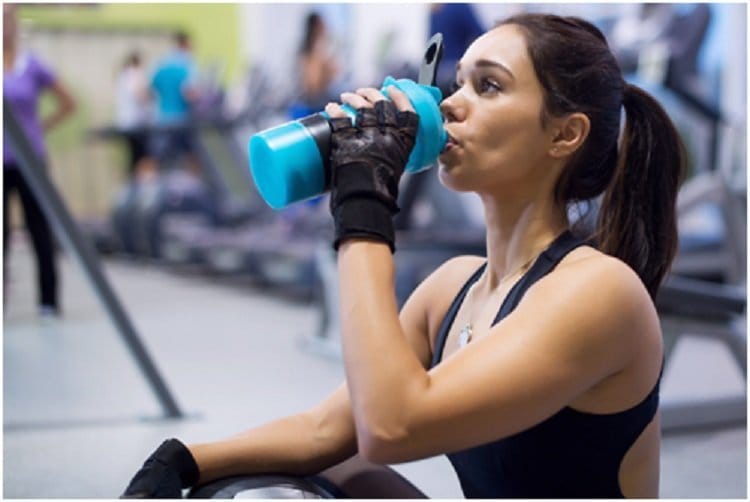You feel great right after working out, thanks to the rush of endorphins it causes. But a few hours or days later, you find yourself sluggish, sore and stiff after the initial high wears off. While tough workouts can definitely be tiring, thankfully there are practical steps you can take to speed up your recovery and combat soreness. Before you grab those tennis shoes for your next workout, check out these nine easy ways you can improve your recovery game and combat soreness after a tough workout.
1. Get plenty of sleep.

Lack of sleep doesn’t just negatively impact your quality of life. It also negatively affects the quality of your workouts and your recovery. Adequate sleep is really important to helping your body recover after serious physical exertion, and all kinds of good things happen when you get enough shuteye–your muscles relax, blood supply to them increases, tissue growth and repair occurs and growth hormone for muscle development is released (among many other benefits!). As an added bonus, more sleep will allow you to perform at your very best during your workout, helping you to avoid mistakes and injuries and creating a positive cycle of energy. A good target would be to aim for around 7-9 hours of sleep per night.
2. Schedule rest days.
Soreness after working out has multiple causes, including lactic acid buildup and inflammation of your muscles. In order to give your body time to recover and the soreness time to dissipate, you should schedule at least one rest day per week, and more if you need it. After all, working out puts a lot of stress on your body, and you need to give it time off to rebuild. Otherwise, you’ll just keep wearing yourself down and potentially even give yourself an injury. Rest days can include a total break from all physical activity, or if you’re feeling up for an active rest day, light yoga, stretching, or walking can all be good options to get your body moving without exerting too much energy and wearing down your muscles.
3. Plan for recovery workouts.
A “go hard or go home” mentality can actually harm you when working out. You should plan easier workouts, such as doing yoga or going for a brisk walk, into your weekly rotation to help your body heal. Then, every 3-5 weeks you should plan an entire week of easier workouts to give your body a “mini vacation” of recovery. These recovery workouts allow you to still get your heart rate and blood flowing without putting quite as much stress on your muscles and bones. This allows you to reap the benefits of recovery without having to entirely take off from working out.
4. Hydrate, hydrate, hydrate.

Hydrating properly before, during and after exercising will make your workout go more smoothly and speed your recovery. Dehydration has all sorts of nasty effects on your body: slowing your cells’ ability to synthesize energy, forcing your heart to pump harder and making it harder to regulate your body temperature, just to name a few symptoms. On the flip side, staying hydrated helps aid muscle repair, promote digestion and reduce fatigue after working out. The American College of Sports Medicine recommends that you “pre-hydrate” with 16 to 20 fluid oz. four hours before exercise, drink as you feel thirsty during your workout and then consume 16 to 24 oz. of water for every pound of fluids lost after working out.
Consider sports drinks.
For most people, water will be enough to help them stay hydrated. But some athletes—especially those who live in hot and humid environments, sweat a lot or have salty sweat, eat a low sodium diet or work out for longer than an hour—drink plenty of water and still find themselves feeling sluggish and exhausted after exercise. In this case, they might want to look into sports drinks, which contain calories, sugar, potassium and other key electrolytes that can quickly replenish the body’s depleted stores after a hard workout. Just make sure to read the label. Some sports drinks contain caffeine, which has a diuretic effect that can exacerbate dehydration.
5. Eat with your workouts in mind.
What you eat can have a major impact on how you feel both during and after workouts. Pre workout, you’ll want to focus on consuming fast acting carbohydrates such a banana for quick energy. Post work out, because of all the calories you burned during exercise, you’ll need to replenish those carbohydrates, which provide the main fuel for your muscles when you exercise. And don’t eat just any carbs. Look for healthful options such as whole-grain products and fruits and vegetables. You should also eat lean protein to help repair and grow your muscles post-workout.
6. Treat yourself to a massage.
Physically kneading the muscles through massages can help dispel soreness, reduce stiffness and increase your mobility after exercise. Not to mention it can be a great way to relax after strenuous physical exertion. Book a session with a masseuse if you’re feeling really sore. If that’s not an option, get yourself a foam roller, which uses gravity to help you give your sore muscles a massage on your own.
7. Make hot and cold work for you.
Using extreme temperatures can help treat muscles soreness, whether that’s through ice packs to reduce inflammation or heating pads to help stiff muscles limber up. If you want to get a little more high tech, you can use joint and muscle warming and cooling sleeves to target particular problem areas and get some relief. A good thing to remember is that you’ll want to use heat before workouts and cold after. The warm temperature will warm the muscle up for exercise whereas the ice will help cool it down and help reduce soreness.
8. Take away the pain.

You won’t always feel sore right away after a workout. Particularly if you’re lifting weights, soreness might manifest as late as 24 to 36 hours after a workout. This is called “delayed onset muscle soreness” (DOMS), and it can make your body feel incredibly stiff and even painful. If you’re having trouble moving or are in a lot of pain, non-steroidal anti-inflammatory drugs (NSAIDs) can help reduce your symptoms and offer relief. NSAIDs won’t cure you, but they can help you make it through those especially sore days. Don’t forget that stretching can help loosen stiff muscles as well and can be good to try if it’s not too painful.
9. Elevate your legs.
Elevating your lower limbs above the level of your heart encourages blood, lactic acid, and other fluids to drain from your legs, which reduces swelling and inflammatory reactions. While some athletes lie down on the floor and rest their legs against the wall, if you don’t want to roll around on a nasty gym floor, you can get a leg rest pillow so you get all the benefits of leg elevation while lying on your clean, comfy couch.
Working out is good for our bodies and our brains—but the sore, stiff muscles and low energy that sometimes come afterwards can make things seem otherwise. Try one or all of these nine recovery tips to help your body heal after a hard workout.


